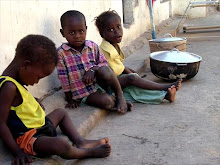 Before I received an email asking from help from Lamin Fofanah, the Chief Executive of Aid for Orphans and the Disabled (AFOD) back in April, I have to admit that I didn't know much about The Gambia, other than it was to be found in West Africa, so I very quickly did some swotting up.
Before I received an email asking from help from Lamin Fofanah, the Chief Executive of Aid for Orphans and the Disabled (AFOD) back in April, I have to admit that I didn't know much about The Gambia, other than it was to be found in West Africa, so I very quickly did some swotting up.
The
Despite the presence of the
The population of the
The extent and effects of the AIDS virus in Africa are well documented and no doubt we are all aware that the majority of people with the disease can be found in
The orphans of AIDS victims and disabled people in most of 
At the Enfys Acumen, we have over twenty years experience of working in some of the poorest communities in the UK and with organisations tackling a wide range of social issues, but working in The Gambia would be something quite different.
It would be a fantastic challenge to apply our skills in organisational development and coaching in a new setting, with a different culture of people and with some of the greatest social needs we have come across.
Wednesday, 24 October 2007
Tell us some more about The Gambia
Posted by
Nigel Griffiths
at
18:29
![]()
Labels: AFOD, aid for orphans and the disabled, AIDS, Gambia, lamin fofanah
Subscribe to:
Post Comments (Atom)




No comments:
Post a Comment